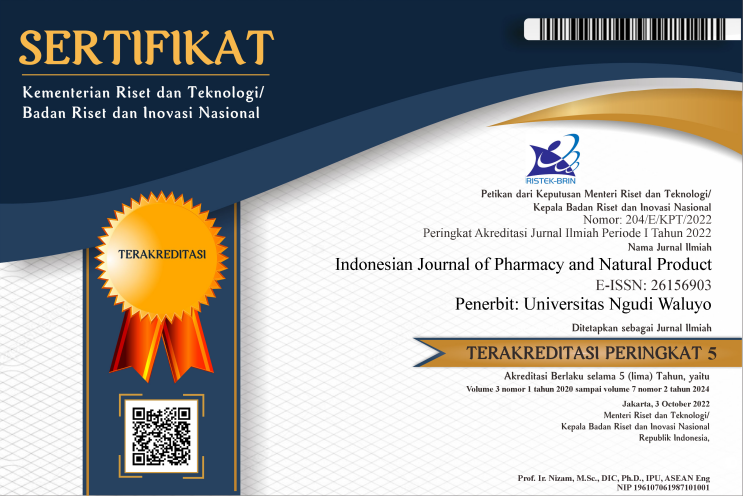Penetapan Kadar Flavonoid Total Ekstrak Etanol Biji Pinang (Areca catechu L.) Menggunakan Metode AlCl3
DOI:
https://doi.org/10.35473/ijpnp.v4i1.888Keywords:
flavonoid, metode AlCl3, ekstrak, purifikasiAbstract
Pinang merupakan tanaman yang banyak tersedia di Indonesia dan memiliki berbagai manfaat. Pemanfaatan air rebusan biji pinang digunakan masyarakat dalam membersihkan dan menyembuhkan luka infeksi. Biji pinang mengandung senyawa fenolik seperti flavonoid, tannin, asam galat, katekin, beta-sitosterol, gum dan asam amino. Biji pinang dilakukan purifikasi untuk mengilangkan zat ballast yang tidak dibutuhkan. Penelitian ini bertujuan untuk menetapkan kadar flavonoid total ekstrak kasar dan ekstrak terpurifikasi. Metode yang digunakan dalam penetapan kadar adalah metode kolorimetri AlCl3. Penetapan kadar flavonoid dilakukan pada panjang gelombang 413,5 nm dengan standar baku pembanding kuersetin. Plot hubungan antara konsentrasi kuersetin versus absorbansi diperoleh persamaan kurva baku sebesar y = 0,0088x – 0,17 dengan nilai R2 sebesar 0,9998. Uji kualitatif menunjukkan ekstrak biji pinang tanpa purifikasi, dengan perlakuan purifikasi n-heksan dan etil asetat mengandung metabolit sekunder diantaranya flavonoid, saponin, tannin dan fenol. Purifikasi pelarut n-heksan didapatkan hasil rendemen lebih banyak dibandingkan ekstrak yang dipurifikasi dengan pelarut etil asetat. Kadar flavonoid ekstrak tanpa purifikasi, ekstrak purifikasi pelarut n-heksan dan etil asetat berturut – turut sebesar 69,13 ; 130,3 ; dan 94,73 mgQE/g. Hal tersebut sebanding dengan perolehan % rendemen tertinggi diperoleh dari ekstrak terpurifikasi n-heksan. Purifikasi pada ekstrak akan menyebabkan hilangnya zat ballast dalam ekstrak sehingga kandungan flavonoid pada ekstrak akan lebih tinggi.
Kata kunci : flavonoid, metode AlCl3, ekstrak, purifikasi
Areca nut is a plant that is widely available in Indonesia and has various benefits. Utilization of boiled betel nut water is used by the community to clean and heal infected wounds. Betel nuts contain phenolic compounds such as flavonoids, tannins, gallic acid, catechins, beta-sitosterol, gum, and amino acids. Areca seeds are purified to remove unnecessary ballast substances. This study aims to determine the total flavonoid levels of crude extract and purified extract. The method used in the assay is the AlCl3 colorimetric method. Determination of flavonoid levels was carried out at a wavelength of 413.5 nm with a quercetin standard. The plot of the relationship between quercetin concentration versus absorbance obtained a standard curve equation of y = 0.0088x - 0.17 with an R2 value of 0.9998. The qualitative test showed that betel nut extract without purification, with purification treatment of n-hexane and ethyl acetate, contained secondary metabolites including flavonoids, saponins, tannins, and phenols. The purification of the n-hexane solvent obtained more yields than the extract purified with ethyl acetate solvent. The flavonoid levels of the extract without purification, the purified extract of n-hexane and ethyl acetate were 69.13; 130.3; and 94.73 mg QE / g. This is comparable to the highest% yield obtained from purified extracts of n-hexane. Purification of the extract will cause the loss of ballast substances in the extract so that the flavonoid content in the extract will be higher.
Keywords: flavonoids, AlCl3Â method, extract, purification
References
Asmorowati, H., & Lindawati, N. Y. (2019). Penetapan kadar flavonoid total alpukat (Persea americana Mill .) dengan metode spektrofotometri. Ilmiah Farmasi, 15(2), 51–63.
Asngad, A., & Bagas, A. R. (2018). Kualitas pembersih Tangan Hand Sanitizer. Aprilia Bagas R, Nopitasari, 4(2), 61–70. https://doi.org/10.23917/bioeksperimen.v4i1.2795
Chang, C. C., Yang, M. H., Wen, H. M., & Chern, J. C. (2002). Estimation of total flavonoid content in propolis by two complementary colometric methods. Journal of Food and Drug Analysis, 10(3), 178–182. https://doi.org/10.38212/2224-6614.2748
El Guiche, R., Tahrouch, S., Amri, O., El Mehrach, K., & Hatimie, A. (2015). Antioxidant activity and total phenolic and flavonoid contents of 30 medicinal and aromatic plants located in the south of Morocco. International Journal of New Technology and Research (IJNTR), 1(3), 7–11.
Hamsar, M. N., Ismail, S., Mordi, M. N., Ramanathan, S., & Mansor, S. M. (2011). Antioxidant activity and the effect of different parts of areca catechu extracts on Glutathione-S-Transferase activity in vitro. Free Radicals and Antioxidants, 1(1), 28–33. https://doi.org/10.5530/ax.2011.1.6
Handayani, F., Sundu, R., & Karapa, H. N. (2016). Uji Aktivitas Ekstrak Etanol Biji Pinang (Areca catechu L.) Terhadap Penyembuhan Luka Bakar Pada Kulit Punggung Mencit Putih Jantan (Mus musculus). Jurnal Ilmiah Manuntung, 2(2), 154–160. Retrieved from https://www.researchgate.net/publication/330533931
Kunti Mulangsri, D. A., & Zulfa, E. (2020). Uji Aktivitas Antibakteri Ekstrak Terpurifikasi Daun Mangga Arumanis (Mangifera indica L.) dan Identifikasi Flavonoid dengan KLT. Jurnal Farmasi Galenika (Galenika Journal of Pharmacy) (e-Journal), 6(1), 55–62. https://doi.org/10.22487/j24428744.2020.v6.i1.14044
Malik, A., Ahmad, A. R., & Najib, A. (2013). Daun Teh Hijau Dan Jati Belanda. Jurnal Fitofarmaka Indonesia, 4(2), 238–240.
Mathur, R., & Vijayvergia, R. (2017). Determination of total flavonoid and phenol content in Mimusops Elengi Linn. International Journal of Pharmaceutical Sciences and Research, 8(12), 5282–5285. https://doi.org/10.13040/IJPSR.0975-8232.8(12).5282-85
Panche, A. N., Diwan, A. D., & Chandra, S. R. (2016). Flavonoids: An overview. Journal of Nutritional Science, 5. https://doi.org/10.1017/jns.2016.41
Puspitasari, A. D., & Pramono, S. (2015). Comparison of Methods of Producing Bee Propolis Purified Extract Based on Total Flavonoid Content Using Rutin As Standard. Traditional Medicine Journal, 20(2), 81–86. https://doi.org/10.22146/tradmedj.8076
Sa’roni, & Adjirni. (2012). Spesifikasi Simplisia Dan Ekstrak Etanol Biji Pinang (Areca catechu L) Asal Tawangmangu Serta Toksisitas Akut Dan Khasiat Hemostatiknya Pada Hewan Coba. Media of Health Research and Development, 15(1 Mar), 1–5. https://doi.org/10.22435/mpk.v15i1Mar.1136.
Samosir, A. P., Runtuwene, M. R. J., & Citraningtyas, G. (2012). Uji Aktivitas Antioksidan Dan Total Flavonoid Pada Ektrak Etanol Pinang Yaki (Areca vestiaria). Jurnal MIPA Univ Sam Ratulangi, 1(2), 1–6.
Senduk, T. W., Montolalu, L. A. D. Y., & Dotulong, V. (2020). Rendemen Ekstrak Air Rebusan Daun Tua Mangrove Sonneratia alba (The rendement of boiled water extract of mature leaves of mangrove Sonneratia alba). Jurnal Perikanan Dan Kelautan Tropis, 11(1), 9–15.
Subedi, L., Timalsena, S., Duwadi, P., Thapa, R., Paudel, A., & Parajuli, K. (2014). Antioxidant activity and phenol and flavonoid contents of eight medicinal plants from Western Nepal. Journal of Traditional Chinese Medicine, 34(5), 584–590. https://doi.org/10.1016/s0254-6272(15)30067-4
Sudarsono, Pudjoarinto, A., Gunawan, D., Wahyuono, S., Donatus, I. A., Drajad, M., Ngatidjan. (1996). Tumbuhan Obat. Pusat Penelitian Obat Tradisional Universitas Gadjah Mada, Yogyakarta.
Yuan, M., Ao, Y., Yao, N., Xie, J., Zhang, D., Zhang, J., Ye, W. (2019). Two new flavonoids from the nuts of Areca catechu. Molecules, 24(16), 1–7. https://doi.org/10.3390/molecules24162862
Yuliani, H., & Rasyid, M. I. (2019). Efek Perbedaan Pelarut terhadap Uji Toksisitas Ekstrak Pineung Nyen Teusalee. Jurnal Fitofarmaka Indonesia, 6(2), 347–352. https://doi.org/10.33096/jffi.v6i2.453



